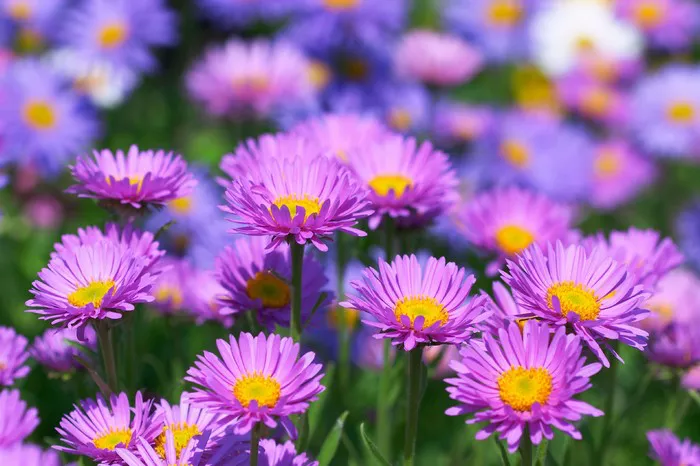Asters, with their delicate petals and vibrant hues, have captivated humanity for centuries. These enchanting flowers are not just a feast for the eyes; they carry profound symbolism that transcends cultures and time periods. From ancient myths to modern interpretations, the aster flower holds a rich tapestry of meanings that reflect aspects of human existence. In this article, we delve deep into the symbolic significance of asters, uncovering the layers of meaning they hold and exploring their cultural resonance across the globe.
Aster Origins and Botanical Characteristics
Before delving into the symbolic meanings of asters, it’s essential to understand their botanical origins and characteristics. Asters belong to the Asteraceae family, which includes over 600 species distributed across various regions of the world. These daisy-like flowers typically feature a prominent yellow center surrounded by colorful ray florets, which can range from shades of purple, pink, blue, and white.
The name “aster” is derived from the Greek word for “star,” a fitting appellation for these flowers with star-shaped blooms. They are primarily native to North America, Europe, and Asia, where they thrive in a variety of habitats, from meadows and woodlands to mountain slopes and marshlands.
Aster Symbolism Across Cultures
Across different cultures and civilizations, asters have held diverse symbolic meanings, often associated with themes of love, patience, and remembrance. Let’s explore some of the prominent cultural interpretations of these captivating flowers:
1. Ancient Greece and Rome: In ancient Greek mythology, asters were believed to have originated from the tears of the goddess Astraea, who wept upon seeing fewer stars in the night sky as humanity descended into darkness. Thus, asters became associated with innocence, purity, and celestial beauty. Similarly, in Roman mythology, asters were linked to Venus, the goddess of love and beauty, symbolizing affection and adoration.
2. China: In traditional Chinese culture, asters are regarded as symbols of fidelity and elegance. They are often featured in art and literature as representations of feminine beauty and grace. Additionally, asters are associated with the notion of “jealousy” in Chinese folklore, where they are believed to protect against envy and ill-wishing.
3. Native American Traditions: Among indigenous communities in North America, asters hold spiritual significance and are used in various rituals and ceremonies. For some tribes, asters symbolize the connection between the physical and spiritual worlds, serving as a bridge between humans and nature. Additionally, asters are valued for their medicinal properties, with some tribes using them as herbal remedies for ailments.
4. Victorian Era: During the Victorian era, the language of flowers, or floriography, was immensely popular as a means of communication. Asters were often associated with sentiments of love and affection, making them a favored choice in floral arrangements and bouquets exchanged between lovers. Pink asters, in particular, were seen as symbols of romantic attraction and admiration.
Modern Interpretations
In contemporary times, the symbolism of asters continues to evolve, reflecting shifting cultural contexts and individual interpretations. While some still adhere to traditional associations, others imbue asters with personal meanings that resonate with their experiences and emotions.
1. Love and Devotion: One of the enduring symbolic meanings of asters is love and devotion. Whether it’s romantic love, familial affection, or platonic friendship, asters are often chosen to convey heartfelt sentiments and deep connections. The vibrant colors of asters, coupled with their delicate appearance, make them ideal tokens of affection for expressing love and appreciation.
2. Patience and Endurance: Another interpretation of aster symbolism is patience and endurance. As resilient flowers that bloom late into the season, asters remind us of the importance of perseverance in the face of adversity. Their ability to thrive in diverse environments serves as a metaphor for resilience and adaptability, inspiring us to persevere through life’s challenges with grace and fortitude.
3. Remembrance and Farewell: In some cultural contexts, asters are associated with remembrance and farewell, particularly in the context of honoring departed loved ones. White asters, in particular, are chosen for their purity and solemnity, serving as poignant symbols of remembrance in funeral arrangements and memorial services. Their presence evokes memories of cherished moments shared with those who have passed on, offering solace and comfort to the grieving.
Conclusion
In conclusion, the aster flower represents a multifaceted tapestry of symbolism that spans cultures, traditions, and historical epochs. From ancient myths to modern interpretations, asters continue to enchant and inspire with their beauty and profound meanings. Whether as symbols of love, patience, remembrance, or resilience, asters hold a timeless allure that resonates deeply with the human experience. As we contemplate the significance of these enchanting flowers, we are reminded of the enduring power of nature to evoke emotions, provoke contemplation, and connect us to the mysteries of existence.


